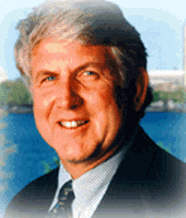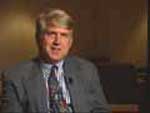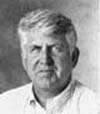As
a graduate student, Bob Metcalfe worked on the ARAPNET at MIT. He later developed a new technology, called Ethernet, for
connecting computers in a local network.
at MIT. He later developed a new technology, called Ethernet, for
connecting computers in a local network.
Work
on the ARAPNET
Metcalfe
was born in 1946, in Brooklyn, NY. He attended MIT where he earned
degrees in electrical engineering and business management. He then
earned a master's degree in applied mathematics from Harvard. While
working on his Ph.D. in computer science at Harvard, he took a job
at MIT building the hardware that would link MIT to the ARPANET. For
a 1972 ARPANET conference he wrote an introductory pamphlet entitled
Scenarios. The booklet included 19 scenarios for using the ARPANET,
listed available resources at the various sites, and basic usage instructions.
Metcalfe
had done a good job writing his informative booklet and was chosen
to take ten AT&T officials on a virtual tour of the network. Unfortunately,
the system crashed while Metcalfe was giving his demonstration. "I
looked up in pain and I caught them smiling, delighted that packet-switching
was flaky," said Metcalfe. "This I will never forget. It confirmed
for them that circuit-switching technology was here to stay, and this
packet-switching stuff was an unreliable toy that would never have
much impact in the commercial world. It was clear to me they were
tangled in the past." (Engelbart
in Hafner & Lyon, 182).
 Metcalfe's
unpleasant experience with the AT&T officials made a lasting impression.
"I saw that there are people who will connive against innovation,"
said Metcalfe. "They're hostile to it. And that has shaped my behavior
ever since." (Engelbart in Kirsner)
Metcalfe's
unpleasant experience with the AT&T officials made a lasting impression.
"I saw that there are people who will connive against innovation,"
said Metcalfe. "They're hostile to it. And that has shaped my behavior
ever since." (Engelbart in Kirsner)
Rejection
and Hawaiian Inspiration
Metcalfe
was excited about the ARAPNET and made it the topic of his doctoral
dissertation. He was shocked when Harvard flunked him. His dissertation
was "not theoretical enough." Metcalfe was angry. "They let me go
into this thing and they gunned me. I'm even willing to stipulate
that it wasn't very good. But I'd still justify my anger at those
bastards for letting me fail. Had they been doing better jobs as professors,
they would never have allowed that to happen. But I hated Harvard
and Harvard hated me. It was a class thing from the start." (Engelbart
in Kirsner)
Metcalfe
had already accepted a job a Xerox's Palo Alto Research Center (PARC).
He was told to come take his job anyway and finish his doctoral work
later. His inspiration for a new dissertation came when he read a
paper about the ALOHA network, or Alohanet at the university of Hawaii.
The Alohanet used radio waves instead of telephone wire to transmit
data. The main problem with using radio waves as a medium was that
if two packets were sent out at the same time on the same broadcast
channel they would interfere with each other and effectively cut off
the transmission.
The
Alohanet designers implemented a method called random access. Computers
were allowed to transmit whenever they had data to send. They then
waited to receive confirmation from the destination computer that
the packets arrived. If packets collided and no  confirmation
was received, the sending computer would wait for a random (but very
short) period of time and retransmit.
confirmation
was received, the sending computer would wait for a random (but very
short) period of time and retransmit.
Metcalfe
saw several problems in the design. He reworked the design and made
it the topic of his new dissertation. His key improvement was to vary
the random interval for re-transmission based on traffic load. If
their was a lot of data traffic, the computer would wait longer periods
before re-transmitting. This would greatly improve efficiency by limiting
the number of repeat collisions. Metcalfe's new dissertation was accepted
and he finally got his Ph.D.
 Vint
Cerf talks about the Alohanet.
Vint
Cerf talks about the Alohanet.
Ethernet
Back
at Xerox PARC, Metcalfe was given the task of designing a way to connect
their new personal computers, the Altos, to each other. He  modified
his version of the Alohanet to use cables instead of radio and with
several other adjustments created a new technology he called Ethernet.
Ethernet worked well and Metcalfe started what would be years of selling
his invention. In 1979, he started his own company, 3Com (which stands
for computers, communication, compatibility) and continued to push
Ethernet a the new standard for local area networks (LANs).
modified
his version of the Alohanet to use cables instead of radio and with
several other adjustments created a new technology he called Ethernet.
Ethernet worked well and Metcalfe started what would be years of selling
his invention. In 1979, he started his own company, 3Com (which stands
for computers, communication, compatibility) and continued to push
Ethernet a the new standard for local area networks (LANs).
Throughout
the 1980s LANs became very popular. They were especially popular at
universities where many workstations were connected using Ethernet.
Those LANs were in turn connected to the Internet to facilitate inter-institution
communication. In this way, Ethernet was influential in the expansion
of the Internet.
For
Further Reading
Internet
Collapses and Other Other InfoWorld Punditry
by Bob Metcalfe

Beyond
Calculation: The Next Fifty Years of Computing
Home|
Vannevar Bush | J.C.R.
Licklider | Larry Roberts | Paul
Baran |
Bob Metcalfe |
Doug Engelbart | Vint Cerf | Ted
Nelson | Tim Berners-Lee |
Marc Andreesen | Epilogue |
References |